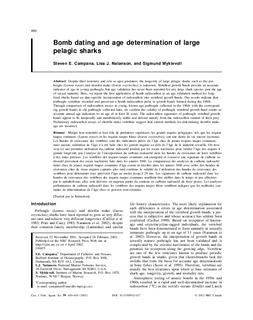Bomb dating and age determination of large pelagic sharks
Journal article, Peer reviewed
Permanent lenke
http://hdl.handle.net/11250/108697Utgivelsesdato
2002Metadata
Vis full innførselSamlinger
- Articles [3012]
Originalversjon
http://dx.doi.org/10.1139/F02-027Sammendrag
Despite their notoriety and role as apex predators, the longevity of large pelagic sharks such as the porbeagle
(Lamna nasus) and shortfin mako (Isurus oxyrinchus) is unknown. Vertebral growth bands provide an accurate
indicator of age in young porbeagle, but age validation has never been reported for any large shark species past the age
of sexual maturity. Here, we report the first application of bomb radiocarbon as an age validation method for longlived
sharks based on date-specific incorporation of radiocarbon into vertebral growth bands. Our results indicate that
porbeagle vertebrae recorded and preserved a bomb radiocarbon pulse in growth bands formed during the 1960s.
Through comparison of radiocarbon assays in young, known-age porbeagle collected in the 1960s with the corresponding
growth bands in old porbeagle collected later, we confirm the validity of porbeagle vertebral growth band counts as
accurate annual age indicators to an age of at least 26 years. The radiocarbon signatures of porbeagle vertebral growth
bands appear to be temporally and metabolically stable and derived mainly from the radiocarbon content of their prey.
Preliminary radiocarbon assays of shortfin mako vertebrae suggest that current methods for determining shortfin mako
age are incorrect.
